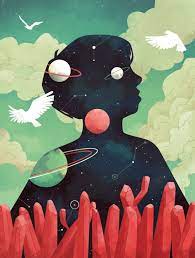Exploring the Fascinating World of Illustration Art
The Art of Illustration
Illustration art is a captivating form of visual expression that has the power to communicate ideas, evoke emotions, and tell stories through images. From intricate pen-and-ink drawings to vibrant digital creations, illustrators use their unique styles and techniques to bring imagination to life.
A Brief History
Illustration has a rich history that dates back centuries. In the early days, illustrations were primarily used in books, newspapers, and advertisements to enhance written content and engage audiences. Over time, illustration evolved into a respected art form in its own right, with artists like Aubrey Beardsley, Alphonse Mucha, and Norman Rockwell making significant contributions to the field.
The Role of Illustrators
Illustrators play a crucial role in visual storytelling across various industries. They create illustrations for children’s books, editorial publications, advertising campaigns, packaging designs, and more. Their ability to convey complex ideas in a visually appealing way makes them invaluable collaborators for writers, designers, and marketers.
Diverse Styles and Techniques
Illustration art encompasses a wide range of styles and techniques, from traditional mediums such as watercolours and pencils to digital tools like graphic tablets and software. Each illustrator brings their unique perspective and artistic flair to their work, resulting in a diverse landscape of visual storytelling.
The Impact of Illustration
Illustrations have the power to inspire imagination, evoke nostalgia, provoke thought, and spark conversations. They can transport viewers to different worlds, evoke strong emotions, or simply bring joy through their aesthetic appeal. In an increasingly visual world, illustration continues to play a vital role in shaping our cultural landscape.
Conclusion
Illustration art is a dynamic and versatile form of creative expression that bridges the gap between words and images. Whether it’s bringing characters to life in a children’s book or creating striking visuals for an advertising campaign, illustrators continue to captivate audiences with their talent and vision. As we celebrate the art of illustration, let us appreciate the beauty and impact it brings to our lives.
Exploring the Benefits of Illustration Art: Creativity, Clarity, Versatility, and Emotional Impact
- Illustration art allows for creative storytelling through visual imagery.
- Illustrations can convey complex ideas in a simple and engaging manner.
- Illustrators have the freedom to explore diverse styles and techniques to express their unique vision.
- Illustration art is versatile and applicable across various industries, from publishing to advertising.
- Illustrations have the power to evoke emotions, spark imagination, and leave a lasting impact on viewers.
Challenges in Illustration Art: Navigating Subjectivity, Time Constraints, Limited Scope, Market Saturation, and Technological Reliance
Illustration art allows for creative storytelling through visual imagery.
Illustration art offers a unique and powerful way to engage viewers through creative storytelling using visual imagery. By combining artistic skill with imagination, illustrators can convey complex narratives, evoke emotions, and capture the essence of a story in a single image. Through their illustrations, artists have the ability to transport audiences to different worlds, evoke nostalgia, and spark curiosity, creating a rich and immersive experience that resonates with viewers on a deep and emotional level.
Illustrations can convey complex ideas in a simple and engaging manner.
Illustration art excels in its ability to convey complex ideas in a simple and engaging manner. By distilling intricate concepts into visual representations, illustrations have the power to communicate with clarity and impact. Through clever use of imagery, symbolism, and visual storytelling techniques, illustrators can make abstract or challenging subjects more accessible and understandable to a wide audience. This unique quality of illustration art not only enhances communication but also fosters deeper engagement and connection with the viewer, making it a valuable tool for conveying messages effectively across various contexts.
Illustrators have the freedom to explore diverse styles and techniques to express their unique vision.
Illustrators possess the remarkable freedom to delve into a multitude of styles and techniques, allowing them to articulate their distinct artistic vision in a truly individualistic manner. This creative liberty empowers illustrators to experiment with various mediums, colours, textures, and forms, enabling them to craft visually compelling narratives that resonate with audiences on a profound level. By embracing this diversity in their approach, illustrators can push the boundaries of traditional artistry and bring forth fresh perspectives that captivate and inspire viewers worldwide.
Illustration art is versatile and applicable across various industries, from publishing to advertising.
Illustration art shines as a versatile and invaluable asset that transcends boundaries, finding relevance and application across a multitude of industries. From enhancing the pages of books to capturing attention in advertising campaigns, illustrations breathe life into concepts and stories with their unique visual language. Their adaptability allows them to seamlessly navigate through publishing, advertising, and beyond, adding depth and creativity to every project they touch.
Illustrations have the power to evoke emotions, spark imagination, and leave a lasting impact on viewers.
Illustration art possesses a remarkable ability to stir emotions, ignite the imagination, and imprint a lasting impression on its viewers. Through the skilful use of colours, shapes, and compositions, illustrations have the power to evoke a wide range of feelings, from joy and nostalgia to contemplation and awe. By transporting viewers to new worlds and narratives, illustrations spark creativity and invite individuals to explore realms beyond their everyday experiences. The lasting impact of illustration art lies in its capacity to connect with audiences on a profound emotional level, leaving a lasting imprint that lingers long after the initial viewing.
Subjectivity
Subjectivity is a significant con of illustration art as the interpretation of illustrations can vary widely among viewers, often leading to potential miscommunication or misunderstanding. Each individual brings their own unique perspective, experiences, and emotions to the viewing process, which can result in different meanings being derived from the same artwork. This subjectivity can sometimes lead to misconceptions or misinterpretations, highlighting the challenge of conveying a clear and consistent message through illustrations.
Time-Consuming
One drawback of illustration art is its time-consuming nature. Crafting intricate illustrations demands a significant amount of time and effort, as artists need to dedicate themselves to achieving precision and detail in their work. The meticulous attention required to bring complex images to life can result in a lengthy creative process, making illustration a time-intensive endeavour that tests the patience and dedication of artists.
Limited Scope
One drawback of illustration art is its limited scope when it comes to conveying complex or abstract concepts. While illustrations excel at capturing visual narratives and evoking emotions, they may struggle to communicate intricate or abstract ideas with the same clarity as other forms of visual communication. The inherent stylization and subjectivity of illustrations can sometimes restrict their ability to convey nuanced or highly technical information, posing a challenge when tackling subjects that require a more straightforward or precise visual representation.
Market Saturation
Market saturation poses a significant challenge in the realm of illustration art. With a plethora of talented artists vying for recognition and opportunities, emerging illustrators often struggle to distinguish themselves in a crowded landscape. The sheer volume of artwork available in the market can make it daunting for new talents to break through and showcase their unique style and vision. As a result, many aspiring artists face hurdles in gaining visibility and securing meaningful opportunities to showcase their work.
Technological Dependency
With the rise of digital illustration tools, traditional illustrators may encounter difficulties in adjusting to the changing landscape of their craft. The increasing technological dependency in the field of illustration poses a conundrum for those accustomed to traditional mediums and techniques. Adapting to new technologies and trends can be a daunting task, requiring artists to embrace digital tools and workflows to stay relevant in an ever-evolving industry. This shift highlights the importance of balancing traditional skills with modern advancements to navigate the challenges posed by technological dependencies in the world of illustration art.


